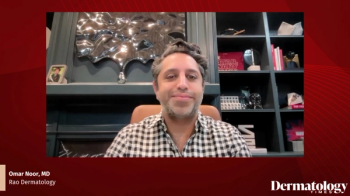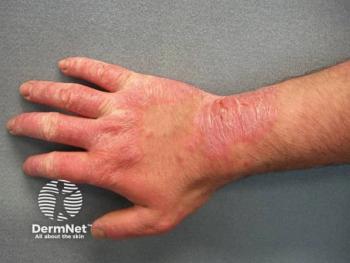
- Dermatology Times, May 2025 (Vol. 46. No. 05)
- Volume 46
- Issue 05
Missed Diagnoses, Missed Opportunities: Closing the Gap in Skin Cancer for Patients of Color
Key Takeaways
- Skin cancer in people of color is often diagnosed at advanced stages, resulting in higher morbidity and mortality rates.
- Misconceptions about melanin's protective benefits contribute to disparities in skin cancer diagnosis and outcomes.
Explore the urgent need for improved skin cancer awareness and care for minority populations, addressing disparities in diagnosis and treatment.
As a fellowship-trained Mohs surgeon, I spend most of my time treating skin cancer and reassuring patients as they face one of the scariest moments of their lives. Although this is a daily occurrence, some cases never leave your thoughts—even after clinic is over. One patient has never left my mind: A 50-year-old Black man who came to the emergency department because of a bleeding lesion on the bottom of his foot. By the time he was finally diagnosed with acral lentiginous melanoma (ALM), the cancer had already metastasized.
He had been to urgent care and family medicine clinics several times over the previous year. Each time, he was told it was a fungal infection and not to worry. He was prescribed topical antifungals but did not see improvement in his symptoms. Unfortunately, there was no biopsy or suspicion of malignancy during those months. When it began to bleed and ulcerate, he went to the emergency department, where an inpatient dermatology consult finally led to a biopsy and the correct diagnosis.
This is not a unique case. This patient’s story is a snapshot of a larger systemic issue in our field. We must urgently call to action the need to improve health care outcomes for health and cancer disparities in minority populations.
The Burden of Skin Cancer in People of Color
Although we know that some UV protection is offered by melanin, we must be careful not to oversell its protective benefits. There is a misconception that patients with darker skin cannot get skin cancer or do not need counseling to prevent it. This myth continues to influence both clinical practice and public perception of skin cancer in people of color.
Multiple research studies have shown that although the reported incidence of skin cancer is lower in people of color, the morbidity and mortality are higher for skin cancer in people of color. It tends to be diagnosed at a more advanced stage with a worse prognosis. Black patients are more likely to have a 5-year survival rate of 70% vs 92% for non-Hispanic White patients.1-3 They are also more likely to be diagnosed with advanced stages of melanoma at presentation. ALM is a subtype of melanoma that is discovered on the fingernails, toenails, and the palmar and plantar surfaces. It tends to be associated with decreased age-adjusted survival and presents at later stages.3-5 Although Black patients have lower melanoma incidence than non-Hispanic White patients, they have increased rates of ALM when diagnosed with melanoma. Studies have also shown that Black patients are more likely to have amputation as a treatment after melanoma diagnosis.6
The journey of my patient with misdiagnosed melanoma is a reminder that we must increase our awareness of cutaneous malignancy in patients of color. People’s lives depend on our ability to recognize patterns in the skin. Limited awareness, delayed diagnosis, and inadequate medical training in recognizing skin cancer in darker skin types contribute to these disparities. Those of us in surgical and cutaneous oncologic subspecialties have the power to do more for these communities.
Where We Go From Here for Patient Care
First, despite the increasing diversification of the US population, medical education largely features skin disease in lighter skin tones. Clinical images in dermoscopy and Kodachromes of pigmented lesions in darker skin types are underrepresented in textbooks and lectures. It is imperative that residency programs integrate more comprehensive training on varying presentations of skin cancer in patients of color. This should not be a separate elective or research track but a core competency integrated into the curriculum.
Second, public health skin cancer campaigns often do not focus on underrepresented communities. We should use platforms such as community partnerships with churches, social media, and health fairs to deliver culturally tailored messaging on skin cancer. Every patient, regardless of melanin content, needs to know that skin cancer can arise, and early detection could save a life.
Finally, culturally competent care includes acknowledging that historical mistrust and barriers to access may lead to delayed diagnoses in patients with skin of color. Prior misdiagnoses in the health care system can affect how patients of color have future interactions with the health care system. Trust should be earned. Focusing on listening to the patient without interruption or judgment can help fortify relationships. When a patient comes into the clinic for a full skin exam, we should examine areas that are often overlooked, such as the soles of the feet and palms of the hands.
Who Gets to Be a Mohs Surgeon?
In addition to gaps in patient care, it is important to address the surgical workforce. Dermatology is one of the least diverse specialties, and Mohs surgery is one of the least diverse subspecialties in dermatology.7 Over the past decade, the proportion of new Black and Hispanic Mohs fellows has consistently declined, hitting a record low of 0.0% during the 2017-2018 and 2018-2019 match cycles.
Studies have shown that representation is directly linked to increased access for underserved communities. Physicians who are also from underrepresented backgrounds are more likely to care for uninsured patients, work in underserved areas, and care for minority populations.8
Many underrepresented students never consider procedural dermatology because they have never seen a Mohs surgeon who looks like them. I have been surprised by the number of students who reach out at conferences and via email looking for a mentor who shares their background and hopefully understands who they are on a personal level. Early exposure through shadowing, research, and structured mentorship programs can improve that trajectory.
For fellowship selection, we should widen the lens. Beyond scores and publications, the fellowship application should focus on distance traveled, leadership, community service, and life experiences outside academia. On a day-to-day basis, an applicant’s commitment to rural or underserved care is just as valuable as a perfect score on the US Medical Licensing Examination. Furthermore, we need to champion diverse Mohs surgeons at every career stage. From residency to faculty leadership, there is an opportunity to support individuals through visibility and advocacy.
During skin cancer awareness months, we can reflect on how we train ourselves, how we serve our patients, and who we invite into our specialty. The male patient mentioned earlier, who walked into the emergency department with the bleeding melanoma, deserved better. He deserved a diagnosis months earlier, when he first sought help from the health care system. He deserved a system that didn’t dismiss his symptoms.
As Mohs surgeons, we are experts in cutaneous oncology and stewards of human connection. It is up to us to advocate with our platform that every patient—regardless of race or background—has access to early, accurate diagnosis and expert surgical care. Let us rise to this challenge—not just during the summer months but as an ongoing imperative in our medical community. Together, we can reshape the narrative of skin cancer care and create a more equitable future for all patients.
Nicole A. Negbenebor, MD, FAAD, is a Mohs micrographic surgery and cutaneous oncology clinical assistant professor and director of the Skin of Color Clinic in the Department of Dermatology at the University of Iowa in Iowa City.
References
- Agbai ON, Buster K, Sanchez M, et al. Skin cancer and photoprotection in people of color: a review and recommendations for physicians and the public. J Am Acad Dermatol. 2014;70(4):748-762. doi:10.1016/j.jaad.2013.11.038
- Harvey VM, Patel H, Sandhu S, Wallington SF, Hinds G. Social determinants of racial and ethnic disparities in cutaneous melanoma outcomes. Cancer Control. 2014;21(4):343-349. doi:10.1177/107327481402100411
- Dawes SM, Tsai S, Gittleman H, Barnholtz-Sloan JS, Bordeaux JS. Racial disparities in melanoma survival. J Am Acad Dermatol. 2016;75(5):983-991. doi:10.1016/j.jaad.2016.06.006
- Cormier JN, Xing Y, Ding M, et al. Ethnic differences among patients with cutaneous melanoma. Arch Intern Med. 2006;166(17):1907-1914. doi:10.1001/archinte.166.17.1907
- Bradford PT, Goldstein AM, McMaster ML, Tucker MA. Acral lentiginous melanoma: incidence and survival patterns in the United States, 1986-2005. Arch Dermatol. 2009;145(4):427-434. doi:10.1001/archdermatol.2008.609
- Collins KK, Fields RC, Baptiste D, Liu Y, Moley J, Jeffe DB. Racial differences in survival after surgical treatment for melanoma. Ann Surg Oncol. 2011;18(10):2925-2936. doi:10.1245/s10434-011-1706-3
- Rehman R, Azam M, Rehman S, Arora H, Kohen L. Gender and ethnic representation of incoming Mohs micrographic surgery fellows in the United States: a look into fellowship diversity. JAAD Int. 2021;6:11-12. doi:10.1016/j.jdin.2021.10.004
- Walker KO, Moreno G, Grumbach K. The association among specialty, race, ethnicity, and practice location among California physicians in diverse specialties. J Natl Med Assoc. 2012;104(1-2):46-52. doi:10.1016/s0027-9684(15)30126-7
Articles in this issue
Newsletter
Like what you’re reading? Subscribe to Dermatology Times for weekly updates on therapies, innovations, and real-world practice tips.



















